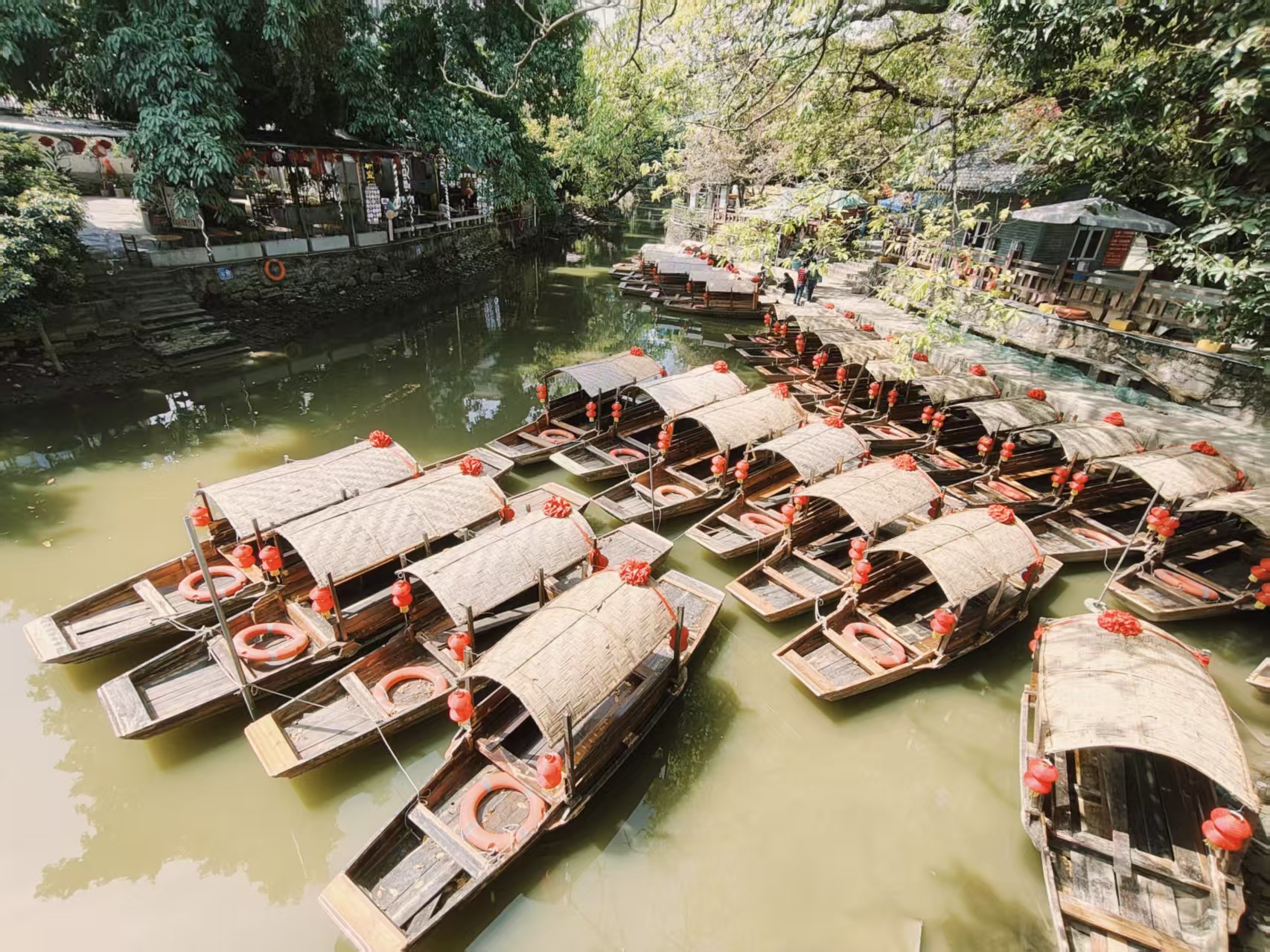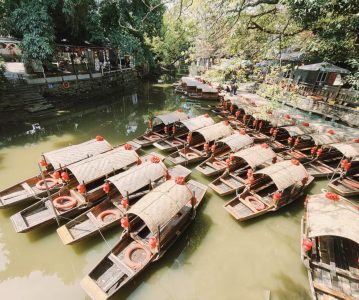Fengjian Water Town-History, Local gourmet, Suggested itineraries & Travel tips
Geographical Coordinates
Nestled in the heart of the Pearl River Delta, Fengjian Water Town spans 5.2 square kilometers at the northern tip of Xingtan Town, Shunde District, Foshan. Its labyrinthine waterways—over 30 kilometers of interlaced canals—carve the village into emerald-green islets, earning it the title “Zhouzhuang of Lingnan.” Silk-like rivers meander beneath arched stone bridges, where black-canopied boats glide past reflections of ancient banyans and gray-tiled houses, composing a living ink-wash painting of Lingnan
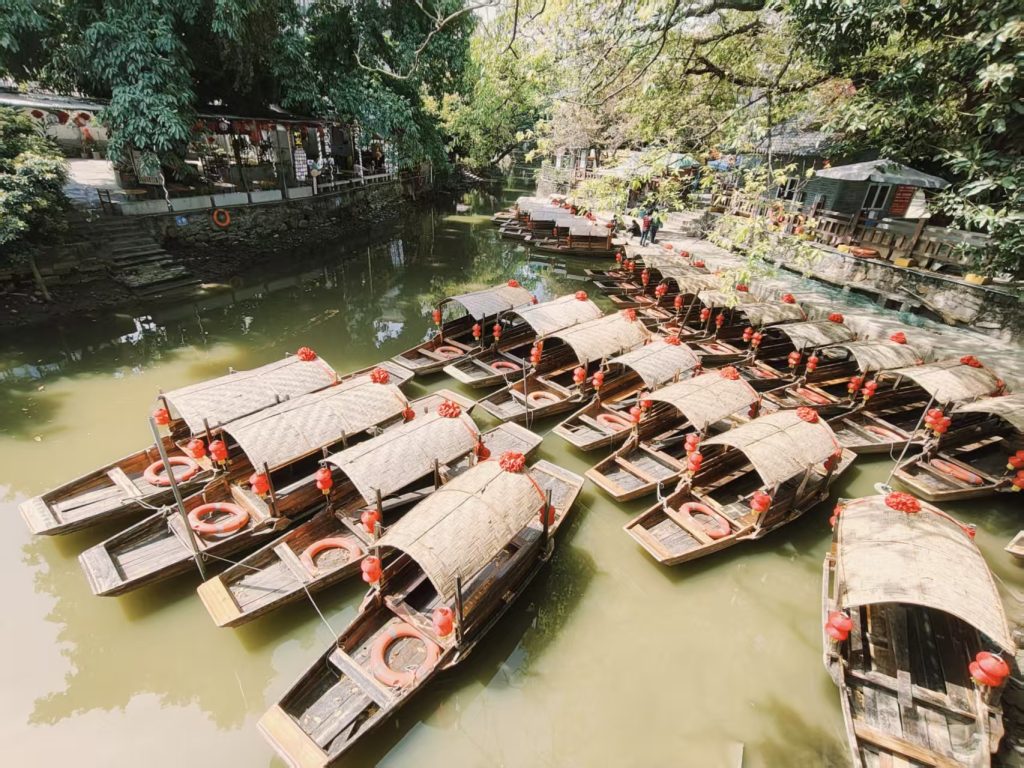
Millennial History
Traces of civilization here date back to the Western Han Dynasty (206 BCE–220 CE), but it flourished during the Song Dynasty (960–1279) as migrants from the Central Plains introduced advanced farming and silk-weaving techniques. By the Ming (1368–1644) and Qing (1644–1912) eras, Fengjian thrived as “Little Guangzhou,” home to 300 clattering looms and 1,500 artisans in three silk markets, exporting lustrous fabrics overseas. Today, moss-clad wharf stones and weathered shopfronts along Guhu Street whisper tales of its mercantile zenith
Accolades
Fengjian is a National AAA-rated scenic area, honored as “China’s Top Rural Tourism Village” and “Guangdong’s Most Beautiful Ancient Village.” Over 70 ancestral halls, a dozen ancient bridges, and millennium-old trees weave a tapestry of “scholarly elegance and watery charm”
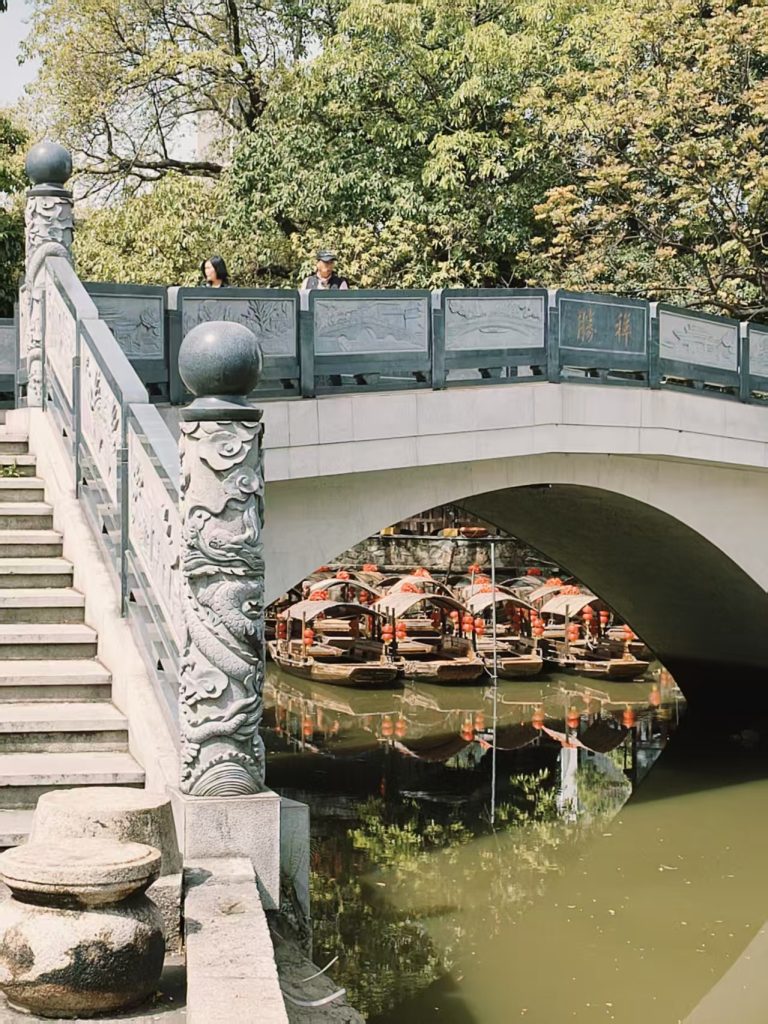
Ideal Seasons
To capture the soul of Fengjian, drift through morning mists (6–8 AM) when dawn gilds the Mingyuan Bridge, or linger at dusk (post-5 PM) to watch the golden sandstone arches of Jin’ao Bridge mirror twin moons on the river, their reflections melting into sunset-stained waters
II. Brushstrokes of History: Timeless Charms
Song Dynasty Triple Bridges
- Mingyuan Bridge: The longest surviving three-arched stone bridge from the Song Dynasty (960–1279) in Guangdong, its 25.1-meter arc straddles the river. Twelve stone lions, weathered yet vigilant after eight centuries, guard the bridgehead, where banyan roots entwine with ivy—a photographer’s muse7.
- Juji Bridge: Rebuilt during the Republic era (1912–1949), this covered bridge hides a secret: Song-era inscriptions forbidding trade on its railings. The lone guardian lion at its dock now gazes upon phantom silk-laden junks of the past.
- Jin’ao Bridge: A Kangxi Emperor-bestowed single-arch marvel, its red sandstone curves cast double lunar reflections on moonlit nights. The imperial osmanthus at its base perfumes the air, symbolizing scholarly triumph.

Ancestral Hall Complexes
- Liu Clan Grand Hall: This Ming Dynasty colossus, crowned by a 7-meter dragon-boat ridge sculpture, now hosts Wing Chun wooden dummies and ceremonial drums. Weekend lion dances animate its courtyards.
- Hezhiliang Hall: Where espresso machines hum beneath Qing-era carved door gods, sip pour-over coffee under the mist-haloed plaques of Liang family scholars.
- Song Canyu Hall: A Mao Zedong-bestowed rifle in its museum silent testimony to the water town’s WWII resistance.
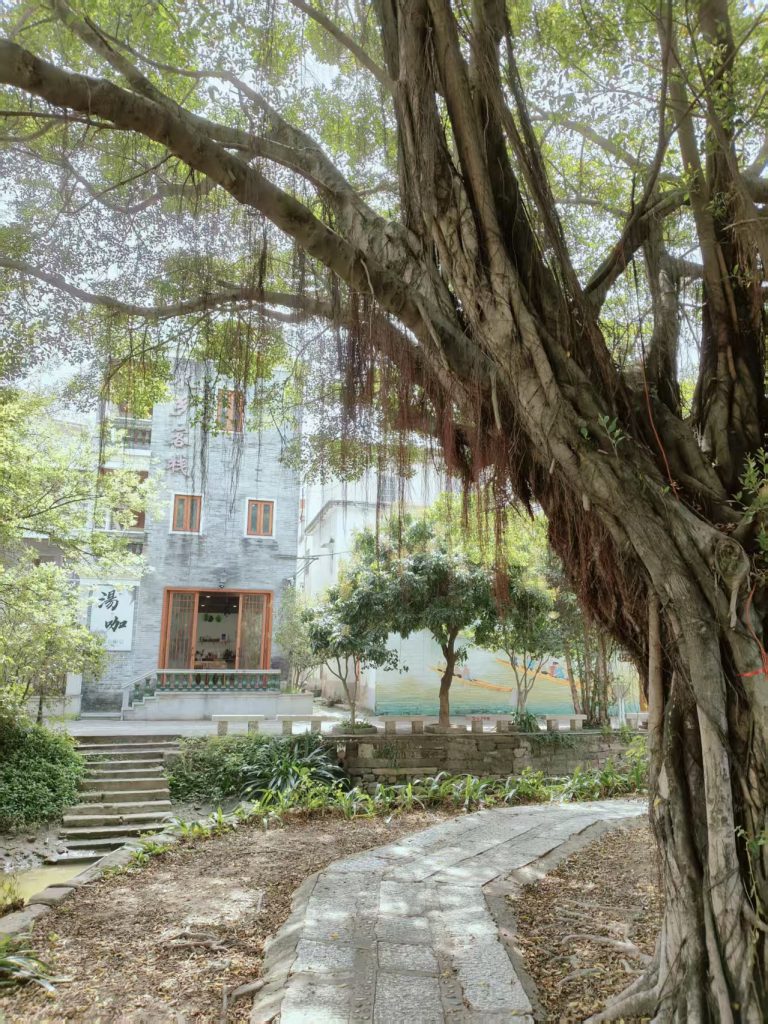
Hidden Gems
- Diaoju Ancient Wharf: Beneath a Qing Jiaqing-era (1796–1820) banyan, a stone tablet decrees “no debris here,” while lapping waves echo silk merchants’ haggling.
- Juemiao Temple: Devotees at this 1850s sanctuary caress frangipani blooms—each petal said to augur wish-fulfillment odds.
- Wetland Park Observatory: Freeze-frame egrets skimming mulberry-dyke fishponds with a 200mm lens, capturing ripples from wingtips.
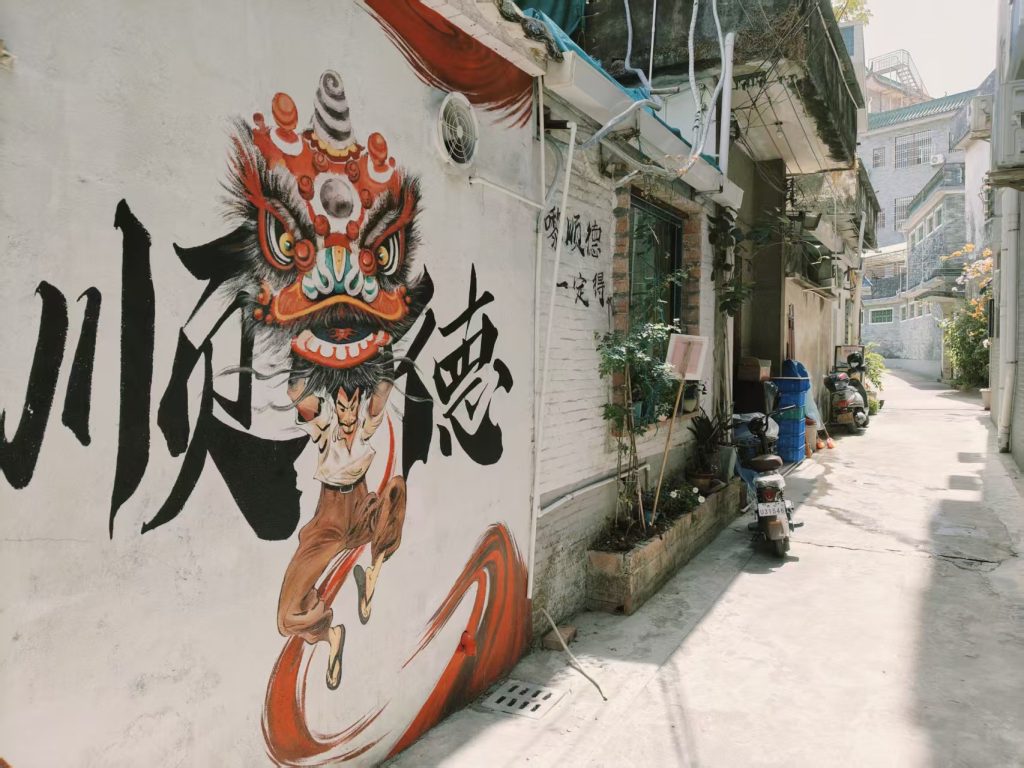
III. Culinary Chronicles: Heritage on a Plate
Epicurean Treasures
- Jun’an Steamed Pork (均安蒸猪): At the Scholar’s Archway eatery, a 50-jin (≈25kg) free-range pig is ice-needle tenderized, smoked over mulberry wood, and sliced razor-thin. Marbled meat infused with pomelo zest pairs with huangpi honey tea to cut richness.
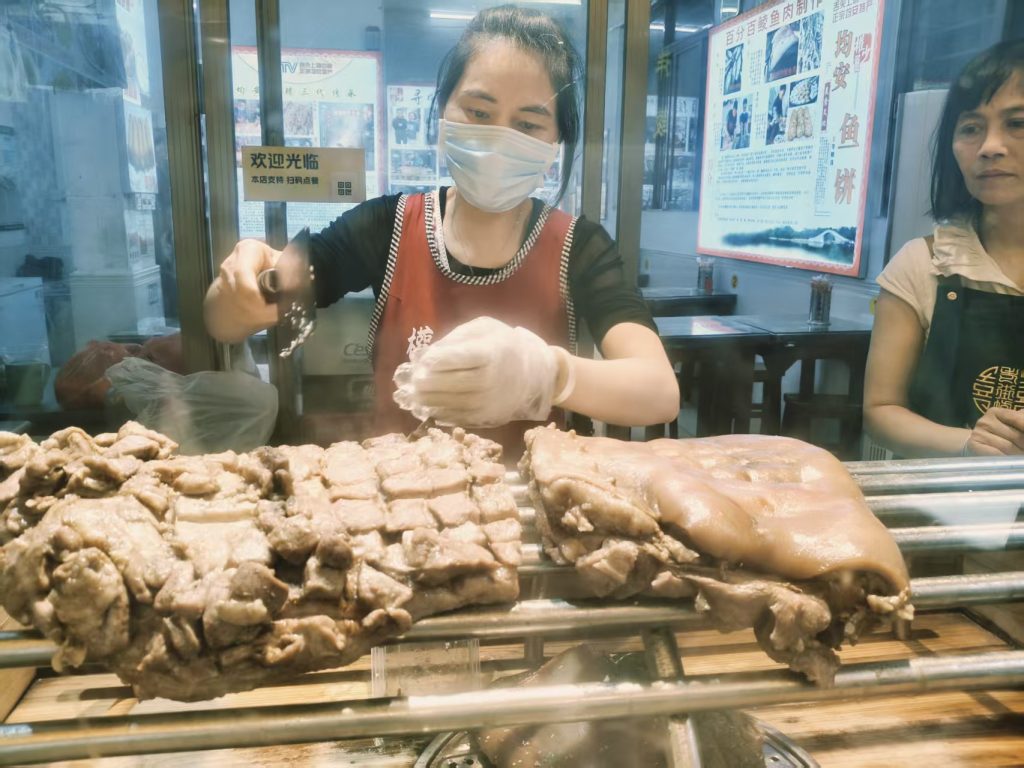
- Crisp Mullet Cake (鲮鱼饼): Hand-pounded fish paste, studded with aged tangerine peel, fries golden. Dip in clam sauce for an umami crescendo.
- Layered Milk Skin (双皮奶): Triple-skinned from water buffalo milk—cooled to a jade-like firmness or served warm like liquid silk. Seek the granny stall near Fengjian Primary for jasmine-orange twists.
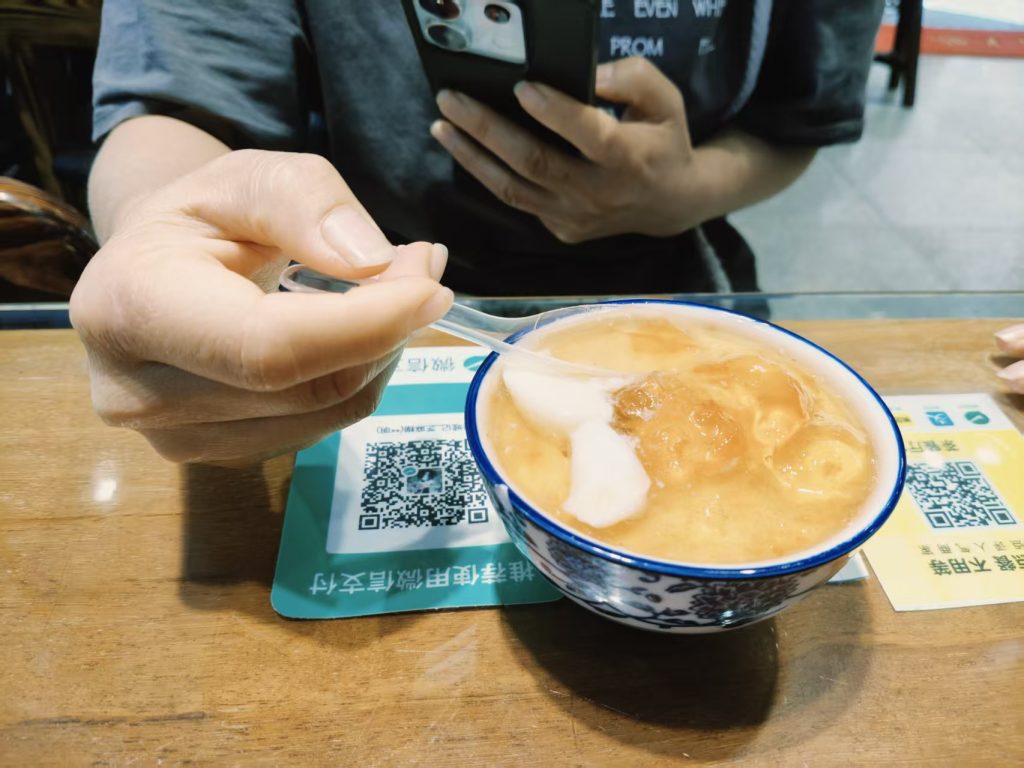
Street-side Delights
- Chilled Fish Skin (凉拌鱼皮): Xijiang mullet skin, flash-frozen then tossed with lime dressing and peanuts, crunches like Chencun rice noodles. Pair with boat congee for textural symphony.
- Golden Milk Nuggets (炸牛奶): A 180°C, 45-second fry seals custard—70% buffalo milk, 30% coconut cream—into crispy lava pockets.
- Lunjiao Sponge Cake (伦教糕): Naturally fermented rice cake,毛孔 (honeycomb pores) cradling rose-sugar snow—a “breathing dessert” immortalized in Flavorful World.
Modern Riffs
- Huangpi Lemon Smash (黄皮柠檬茶): Century-old well water brews with smashed yellow fruit and lemongrass, bottomed with konjac pearls.
- Crab-Stuffed Sticky Rice (糯米蒸蟹): Autumn-limited lotus wraps where glutinous rice soaks up crab roe’s brine. Sip mulberry wine for a “drunken crab” finish.
- Silkworm Chrysalis Broth (蚕蛹虫草汤): Silky pupae meet bitter cordyceps in clay pots—a Ming-Qing silk legacy in every sip.
IV. Immersive Itinerary Design
One-Day Highlights
07:30 Morning Mist Photography at Mingyuan Bridge
Carry a tripod and polarizing filter to capture the bridge’s hazy reflection in dawn mist. With fog draping the river like silk and stone lions emerging from golden light, use f/8 aperture + 1/60s shutter speed to render water’s silky texture.
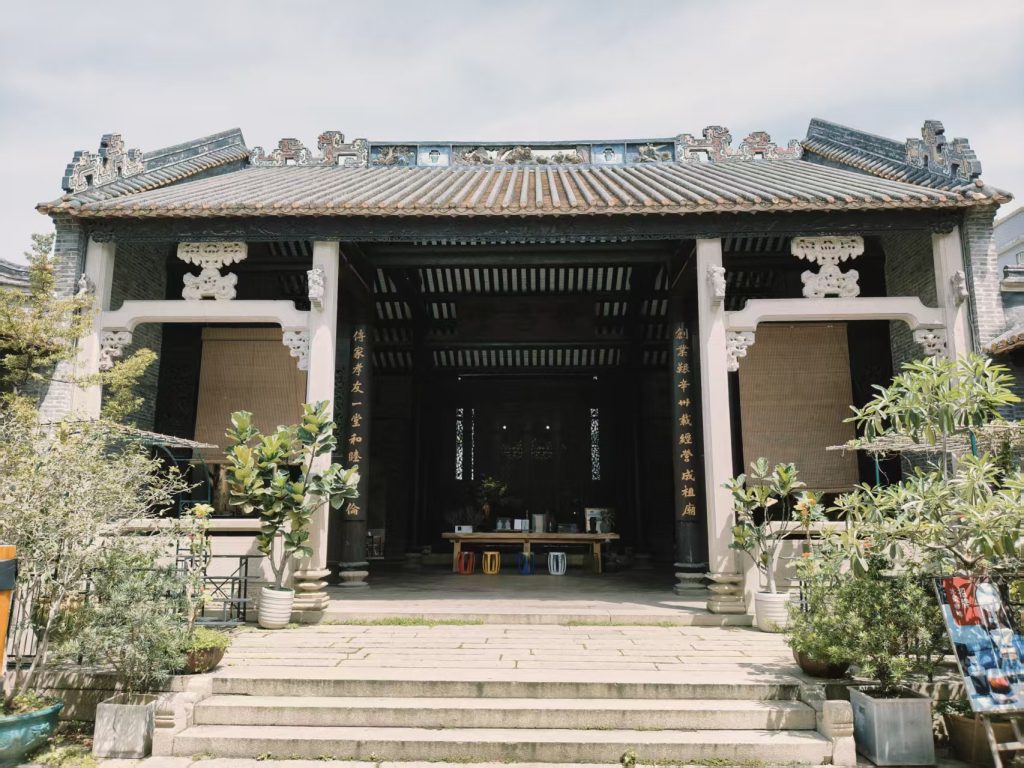
09:00 Wing Chun Martial Arts at Liu Clan Ancestral Hall
Witness intangible heritage performances every weekend. Red-lacquered wooden dummies and carved screens form a natural stage, while silk lanterns sway with performers’ movements—a visual symphony.
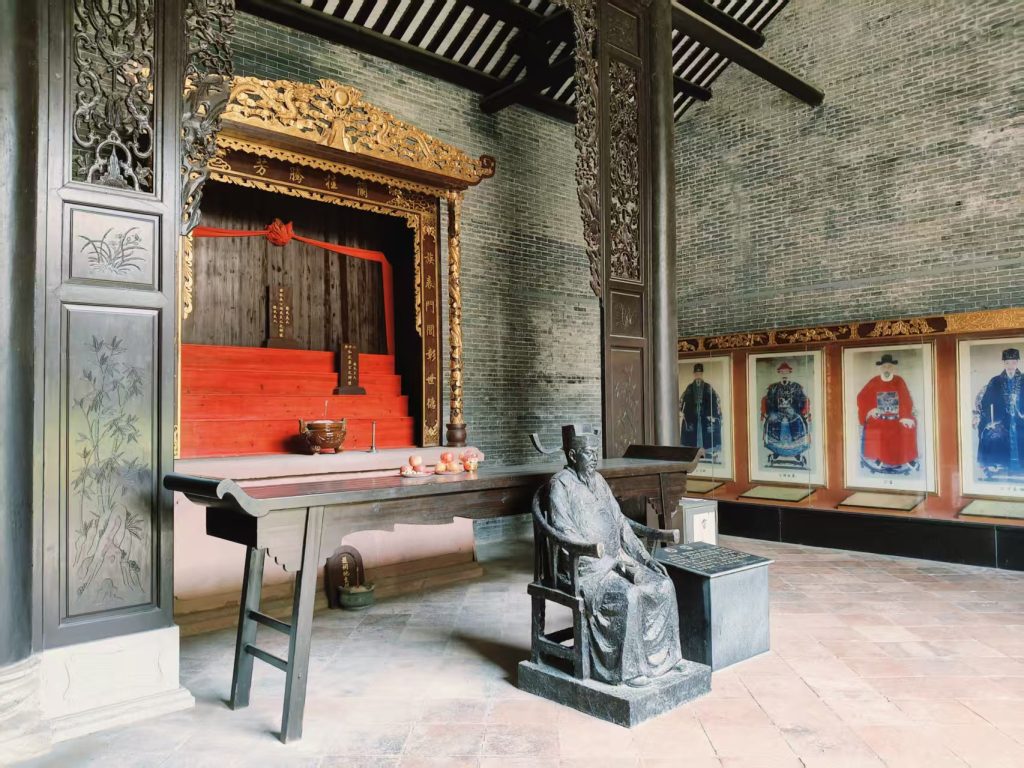
11:00 Handcrafted Coffee at Hezhiliang Hall
Brew pour-over under 100-year-old gray sculptures. Baristas teach secrets of 80°C ancient well water brewing, paired with tangerine-peel shortbread for a bittersweet time-travel experience.
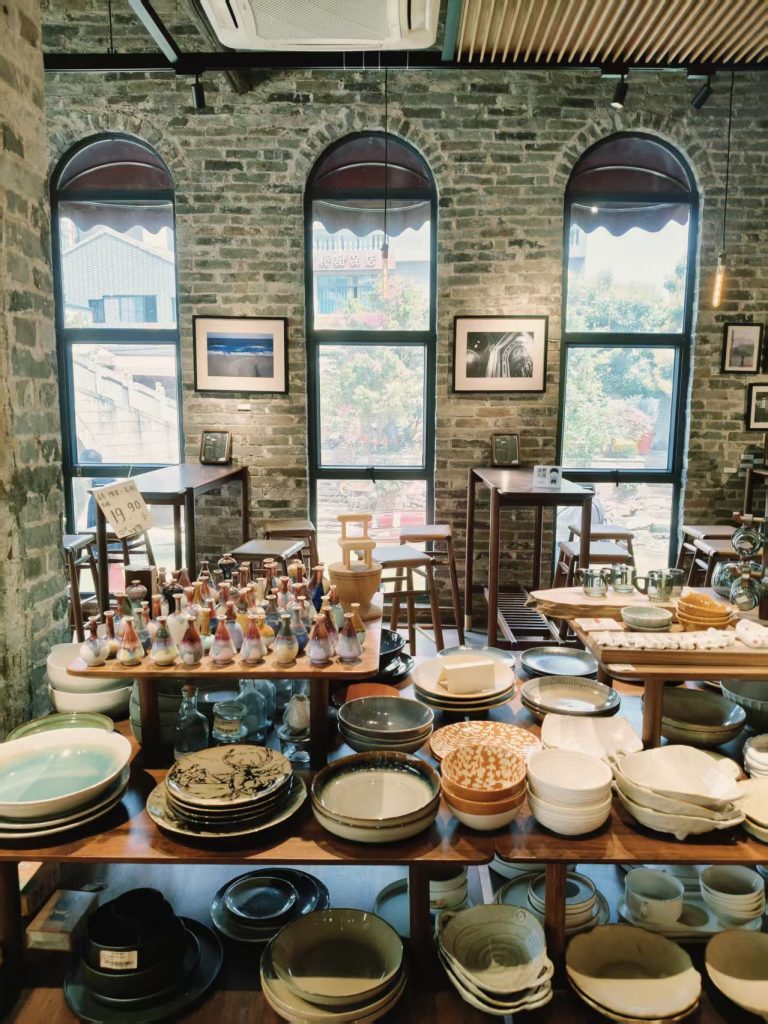
12:30 Lunch at Scholar’s Archway Food Street
Dine at Thirteen Scholars restaurant, where the trio of dishes—traditionally steamed pork, clam-stirred water chestnuts, and mulberry-leaf fish soup—mirror the 13 scholars engraved on the arch.
14:00 Boat Exploration (Juji Bridge Dock)
Choose midday to avoid harsh sun. Boatwomen rowing to Mulberry-Pond Ballads reveal hidden merchant engravings under Juji Bridge—faded Republic-era logos still visible.
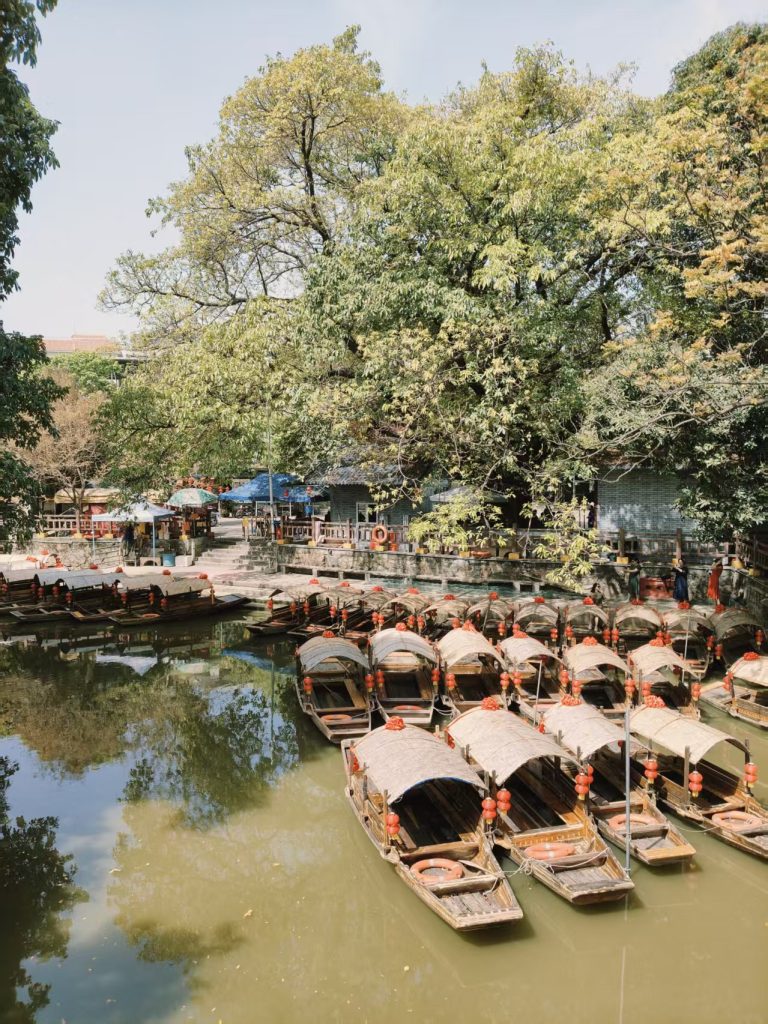
16:00 Blessings at Juemiao Temple
Draw a Silkworm Flower Fortune on mulberry-leaf paper. The abbot ties red cocoon pendants for love seekers beneath 1850s frangipani trees.
17:30 Sunset at Jin’ao Bridge
Arrive 30 mins early. As amber light bathes red sandstone, dual moon-shaped reflections form. Use 70mm focal length to frame imperial osmanthus silhouettes with meticulous brushstroke-like details.
19:00 Stay at Water Town Inn
Opt for a carved-bed suite blending smart toilets with century-old lattice windows. Hidden Bluetooth speakers disguised as copper kettles play Raindrops on Banana Leaves for bedtime serenity.
Two-Day Deep Dive
Night 1:
- Night River Lights (19:30–21:00): LED lotus floats illuminate waterways while Shunde Silk Road animations project onto Jin’ao Bridge. Capture light trails with a 24mm wide-angle lens.
- Silk Dyeing Workshop: At Silkworm Shadow Studio, craft gradient scarves using local Chinese tallow leaves. Collect your indigo masterpiece the next morning.
Day 2:
- Mulberry-Fishpond Cycling (9:00): Pedal through 1,000-year-old ecosystems. Watch silk-reeling demos where farmers boil cocoons in cauldrons.
- Dragon Boat Ballads (15:00): At Liu Hall, pipa-accompanied Water Town Chronicles narrate local life. Dry ice “smoke” rises during Shenshi (3–5 PM) verses, enhancing the drama.
V. Practical Toolkit
Transportation
- Driving: Navigate to Fengjian Market Parking (¥10/day). Arrive before 7:30 for banyan-shaded spots. Scan QR codes on tickets for 3 free hours.
- Bus: Take K990 Express from Guangzhou South Station (1.5hrs). Transfer to Foshan Bus 312 (marked Water Town Special Line).
- Boat: Book the Noon Canal Route (¥150/5 people) to glide through wild lotuses. Share boats at Juji Dock for ¥30 off.
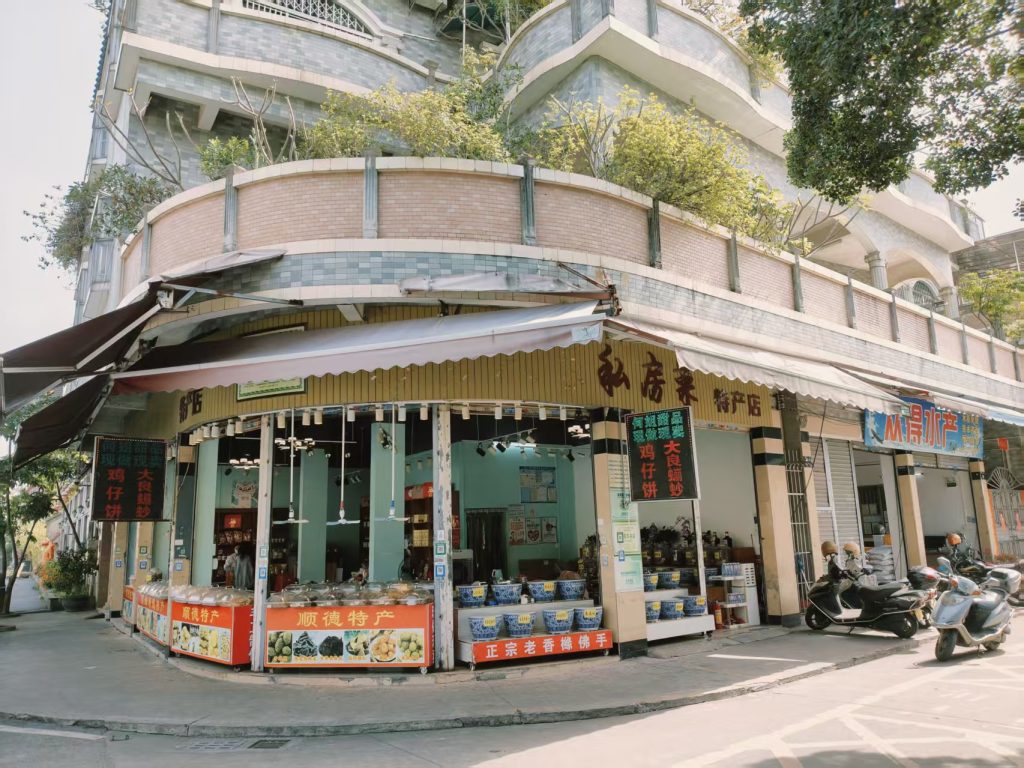
Accommodation
- Blue House: A Huo’er-style house turned stargazing den with retractable skylight and Lingnan Star Atlas guides.
- Water Town Inn: Ming-Qing chambers merge wireless charging beds with oyster shell walls—natural humidity control.
- Koi Boat Loft: Sleep on a retired dragon boat. Rotating BBQ grills and riverside film projections crown the rooftop.
Pro Tips
- Shopping: Avoid packaged dried eel. At Fengjian Market (6:30 AM), vendors gift lemongrass with fresh Diaosidanzhu fish.
- Boat Hours: Skip 11 AM–2 PM when cabin temps hit 45°C. Use foldable reflectors for flattering onboard portraits.
- Luggage: Scan faces at Storage Hut lockers near docks (¥2/hr, max ¥15). Perfect for hands-free exploring.
VI. Creative Inspiration Bank
Photography
- Bridge Reflections: f/8 + 1/125s + polarizer reveals jade-toned arches. Wait for ripples to still for mirror effects.
- Ancestral Carvings: 70mm macro + ring light highlights gold-leaf fragments and hidden porcelain inlays on ridge sculptures.
- Misty Portraits: At Diaoju Wharf, pose with oil-paper umbrellas under banyan roots. 85mm + 5500K enhances cerulean haze.
Cultural Easter Eggs
- Jin’ao Bridge’s scholar hat pillars symbolize academic success. Rubbing the third bat浮雕 (left side) allegedly boosts exam luck.
- Scholar Archway’s hidden inscriptions—tilt phone flash to reveal Li Xiuxiu, 1274 in gilt script—a tribute to Song Dynasty scholars.
Festival Magic
- Dragon Boat Fest (May): Row century-old cedar dragon boats. Masters teach water-splashing technique for 20% speed boost.
- Mid-Autumn (Sep): Silkworm-cocoon lanterns float alongside drone “Jade Rabbits.” Best views at Juemiao’s lotus pond.
- Winter Solstice (Dec): Feast on Four Great Fishes banquets at Liu Hall. The Silk-Reeling Chant echoes through smoky halls.

